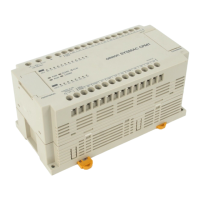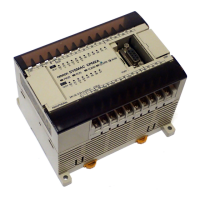98
4-10 Programming Precautions
The number of conditions that can be used in series or parallel is unlimited as
long as the memory capacity of the PC is not exceeded. Therefore, use as many
conditions as required to draw clear diagrams. Although very complicated dia-
grams can be drawn with instruction lines, there must not be any conditions on
lines running vertically between two other instruction lines. Diagram A shown
below, for example, is not possible, and should be drawn as diagram B. Mne-
monic code is provided for diagram B only; coding diagram A would be impossi-
ble.
Diagram A
Diagram B
Address Instruction
00000 LD 000001
00001 AND 000004
00002 OR 000000
00003 AND 000002
00004 Instruction 1
00005 LD 000000
00006 AND 000004
00007 OR 000001
00008 AND NOT 000003
00009 Instruction 2
Operands
0000
00
0000
01
0000
02
0000
03
0000
04
0000
01
0000
00
0000
04
0000
02
0000
00
0000
01
0000
04
0000
03
Instruction 1
Instruction 2
Instruction 2
Instruction 1
The number of times any particular bit can be assigned to conditions is not lim-
ited, so use them as many times as required to simplify your program. Often,
complicated programs are the result of attempts to reduce the number of times a
bit is used.
Except for instructions for which conditions are not allowed (e.g., INTERLOCK
CLEAR and JUMP END, see below), every instruction line must also have at
least one condition on it to determine the execution condition for the instruction
at the right. Again, diagram A , below, must be drawn as diagram B. If an instruc-
tion must be continuously executed (e.g., if an output must always be kept ON
while the program is being executed), the Always ON Flag (A50013) in the Auxil-
iary Area can be used.
Diagram A
Diagram B
Address Instruction
00000 LD A50013
00001 Instruction
Operands
Instruction
A500
13
Instruction
There are a few exceptions to this rule, including the INTERLOCK CLEAR,
JUMP END, and step instructions. Each of these instructions is used as the se-
cond of a pair of instructions and is controlled by the execution condition of the
first of the pair. Conditions should not be placed on the instruction lines leading to
these instructions. Refer to
Section 5 Instruction Set
for details.
Programming Precautions Section 4-10

